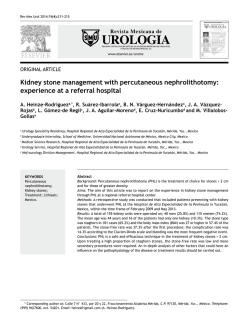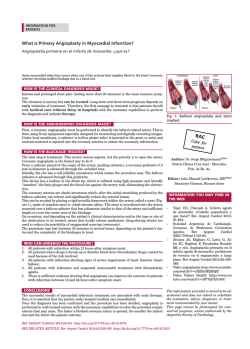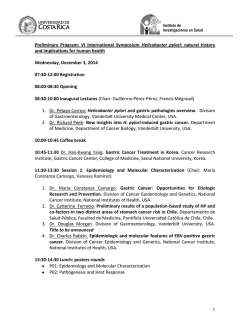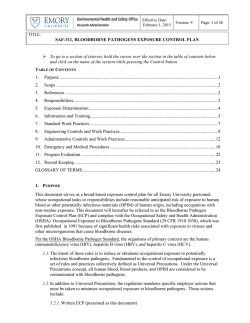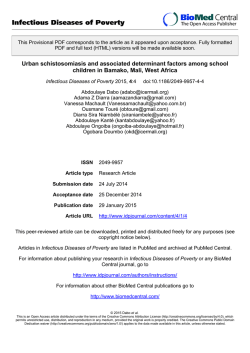
The Ific | International Federation of Infection Control
1. The Impact of Multifocused Interventions on Sharps Injury Rates at an Acute Care Hospital • Robyn R.M. Gershon, MHS, DrPH; Lisa Pearse, MD, MPH; Martha Grimes, RN; Patricia A. Flanagan, BA; David Vlahov, PhD Infection Control and Hospital Epidemiology. Volume 20, Issue 12, Page 806– 811, Dec 1999 OBJECTIVE. To determine the impact of a multifocused interventional program on sharps injury rates. DESIGN: Sharps injury data were collected prospectively over a 9 period (1990 1998). Pre year and postinterventional rates were compared after the implementation of sharps injury prevention interventions, which consisted of administrative, work practice, and engineering controls (ie, the introduction of an anti needlestick intravenous catheter and a new sharps disposal system). SETTING. Sharps injury data were collected from healthcare workers employed by a mid sized, acute care community hospital. RESULTS. Preinterventional annual sharps injury incidence rates decreased significantly from 82 sharps injuries/1,000 worked full time–equivalent employees (WFTE) to 24 sharps injuries/1,000 WFTE employees postintervention (P<.0001), representing a 70% decline in incidence rate overall. Over the course of the study, the incidence rate for sharps injuries related to intravenous lines declined by 93%, hollow and non–hollow bore needlesticks decreased by 75%, bore injuries decreased by 25%. CONCLUSION. The implementation of a multifocused interventional program led to a significant and sustained decrease in the overall rate of sharps injuries in hospital based healthcare workers. 2. Evaluating Sharps Safety Devices: Meeting OSHA’s Intent • Gina Pugliese, RN, MS; Teresa P. Germanson, PhD; Judene Bartley, MS, MPH; Judith Luca, RN; Lois Lamerato, PhD; Jack Cox, MD; Janine Jagger, MPH, PhD Infection Control and Hospital Epidemiology. Volume 22, Issue 7, Page 456–458, Jul 2001 ABSTRACT The Occupational Safety and Health Administration (OSHA) revised the Bloodborne Pathogen Standard and, on July 17, 2001, began enforcing the use of appropriate and effective sharps devices with engineered sharps injury protection. OSHA requires employers to maintain a sharps injury log that records, among other items, the type and brand of contaminated sharps device involved in each injury. Federal OSHA does not require needlestick injury rates to be calculated by brand or type of device. A sufficient sample size to show a valid comparison of safety devices, based on injury rates, is rarely feasible in a single facility outside of a formal research trial. Thus, calculations of injury rates should not be used by employers for product evaluations to compare the effectiveness of safety devices. This article provides examples of sample size requirements for statistically valid comparisons, ranging from 100,000 to 4.5 million of each device, depending on study design, and expected reductions in needlestick injury rates. 3. Occupational Exposure to Blood or Body Fluids as a Result of Needlestick Injuries and Other Sharp Device Injuries Among Medical Residents in Japan • Koji Wada, MD, MSc; Rie Narai, MD; Yumi Sakata, MD; Toru Yoshikawa, MD; Masashi Tsunoda, MD, PhD; Katsutoshi Tanaka, MD, PhD; Yoshiharu Aizawa, MD, PhD Infection Control and Hospital Epidemiology. Volume 28, Issue 4, Page 507–509, Apr 2007 4. Workers' Compensation Claims for Needlestick Injuries Among Healthcare Workers in Washington State, 1996–2000 • Syed M. Shah, MD; David Bonauto, MD; Barbara Silverstein, PhD; Michael Foley, PhC Infection Control and Hospital Epidemiology. Volume 26, Issue 9, Page 775–781, Sep 2005 OBJECTIVES. To characterize accepted workers’ compensation claims for needlestick injuries filed by healthcare workers (HCWs) in non hospital compared with hospital settings in Washington State. DESIGN. Descriptive study of all accepted workers’ compensation claims filed between 1996 and 2000 for needlestick injuries. PARTICIPANTS. All Washington State HCWs eligible to file a state fund workers’ compensation claim and those who filed a workers’ compensation claim for a needlestick injury. RESULTS. There were 3,303 accepted state fund HCW needlestick injury claims. The incidence of needlestick injury claims per 10,000 full time–equivalent HCWs in hospitals was 158.6; in dental offices, 104.7; in physicians’ offices, 87.0; and in skilled nursing facilities, 80.8. The most common mechanisms of needlestick injury by work location were as follows: for hospitals, suturing and other surgical procedures (16.7%), administering an injection (12.7%), and drawing blood (10%); for dentists’ offices, recapping (21.3%) and cleaning trays and instruments (18.2%); for physicians’ offices, disposal (22.2%) and administering an injection (10.2%); and for skilled nursing facilities, disposal (23.7%) and administering an injection (14.9%). Nurses accounted for the largest (29%) proportion of HCWs involved, followed by dental assistants (17%) and laboratory technicians and phlebotomists (12%) in non hospital settings. Rates of needlestick injury claims increased for non hospital settings by 7.5% annually (95% confidence interval [CI95], 4.89% to 10.22%; P < .0001). Rates decreased for hospital settings by 5.8% annually, but the decline was not statistically significant (CI95, 12.50% to 1.34%; P < .1088). HCWs were exposed to hepatitis B, hepatitis C, and human immunodeficiency viruses in non hospital settings. CONCLUSION. There was a difference in the incidence rate and mechanisms of needlestick injuries on review of workers’ compensation claim records for HCWs in non hospital and hospital settings. 5. Costs and Benefits of Measures to Prevent Needlestick Injuries in a University Hospital • Françoise Roudot Thoraval, MD; Olivier Montagne, MD; Annette Schaeffer, MD; Marie Laure Dubreuil Lemaire, MD; Danièle Hachard, RN; Isabelle Durand Zaleski, MD, PhD Infection Control and Hospital Epidemiology. Volume 20, Issue 9, Page 614–617, Sep 1999 OBJECTIVE. To document the costs and the benefits (both in terms of costs averted and of injuries averted) of education sessions and replacement of phlebotomy devices to ensure that needle recapping did not take place. DESIGN. The percentage of recapped needles and the rate of needlestick injuries were evaluated in 1990 and 1997, from a survey of transparent rigid containers in the wards and at the bedside and from a prospective register of all injuries in the workplace. Costs were computed from the viewpoint of the hospital. Positive costs were those of education and purchase of safer phlebotomy devices; negative costs were the prophylactic treatments and followup averted by the reduction in injuries. SETTING. A 1,050 bed tertiary care university hospital in the Paris region. RESULTS. Between the two periods, the proportion of needles seen in the containers that had been recapped was reduced from 10% to 2%. In 1990, 127 needlestick (12.7/100,000 needles) and 52 recapping injuries were reported versus 62 (6.4/100,000 needles) and 22 in 1996 and 1997. When the rates were related to the actual number of patients, the reduction was 76 injuries per year. The total cost of information and preventive measures was $325,927 per year. The cost effectiveness was $4,000 per injury prevented. CONCLUSION. Although preventive measures taken to ensure reduction of needlestick injuries appear to have been effective (75% reduction in recapping and 50% reduction in injuries), the cost of the safety program was high. 6. Use of Safety Devices and the Prevention of Percutaneous Injuries Among Healthcare Workers • Victoria Valls, MD; M. Salud Lozano, RN; Remedios Yánez, RN; María José Martínez, RN; Francisco Pascual, MD; Joan Lloret, MD; Juan Antonio Ruiz, MD Received: March 12, 2007Accepted: July 6, 2007 Infection Control and Hospital Epidemiology. Volume 28, Issue 12, Page 1352– 1360, Dec 2007 Corresponding Author: Address reprint requests to Victoria Valls, MD, Hospital Virgen de la Salud–Elda, Departamento de Salud 18, Carretera Elda Sax s/n, 03600 Elda, Alicante, Spain ([email protected]). Objective. To study the effectiveness of safety devices intended to prevent percutaneous injuries. Design. Quasi experimental trial with before and after intervention evaluation. Setting. A 350 bed general hospital that has had an ongoing educational program for the prevention of percutaneous injuries since January 2002. Methods. In October 2005, we implemented a program for the use of engineered devices to prevent percutaneous injury in the emergency department and half of the hospital wards during the following procedures: intravascular catheterization, vacuum phlebotomy, blood gas sampling, finger stick blood sampling, and intramuscular and subcutaneous injections. The nurses in the wards that participated in the intervention received a 3 course on occupationally acquired bloodborne infections, and they had a 2 hour hour “hands on” training session with the devices. We studied the percutaneous injury rate and the direct cost during the preintervention period (October 2004 through March 2005) and the intervention period (October 2005 through March 2006). Results. We observed a 93% reduction in the relative risk of percutaneous injuries in areas where safety devices were used (14 vs 1 percutaneous injury). Specifically, rates decreased from 18.3 injuries (95% confidence interval [CI], 5.9 per 100,000 patients in the emergency department ( CI, 20.1 83.6 injuries) to 5.2 injuries (95% CI, 0.1 in hospital wards ( 43.2 injuries) to 0 injuries ) and from 44.0 injuries (95% 28.8 injuries) per 100,000 patient days ). In the control wards of the hospital (ie, those where the intervention was not implemented), rates remained stable. The direct cost increase was €0.558 (US$0.753) per patient in the emergency department and €0.636 (US$0.858) per patient day in the hospital wards. Conclusion. Proper use of engineered devices to prevent percutaneous injury is a highly effective measure to prevent these injuries among healthcare workers. However, education and training are the keys to achieving the greatest preventative effect. 7. Effect of Implementing Safety-Engineered Devices on Percutaneous Injury Epidemiology • SeJean Sohn, MPH; Janet Eagan, RN, MPH; Kent A. Sepkowitz, MD; Gianna Zuccotti, MD, MPH Infection Control and Hospital Epidemiology. Volume 25, Issue 7, Page 536–542, Jul 2004 OBJECTIVE. To assess the effect of implementing safetyengineered devices on percutaneous injury epidemiology, specifically on percutaneous injuries associated with a higher risk of blood borne pathogen exposure. DESIGN. Before and (1998–2000) and 1 after intervention trial comparing 3 year preintervention year postintervention (2001–2002) periods. Percutaneous injury data have been entered prospectively into CDC NaSH software since 1998. SETTING. A 427 bed, tertiary care hospital in Manhattan. PARTICIPANTS. All employees who reported percutaneous injuries during the study period. INTERVENTION. A “safer needle system,” composed of a variety of safety engineered devices to allow for needlesafe IV delivery, blood collection, IV insertion, and intramuscular and subcutaneous injection, was implemented in February 2001. RESULTS. The mean annual incidence of percutaneous injuries decreased from 34.08 per 1,000 full time–equivalent employees preintervention to 14.25 postintervention (P < .001). Reductions in the average monthly number of percutaneous injuries resulting from both low risk (P < .01) and high risk (P was not significant) activities were observed. Nurses experienced the greatest decrease (74.5%, P < .001), followed by ancillary staff (61.5%, P = .03). Significant rate reductions were observed for the following activities: manipulating patients or sharps (83.5%, P < .001), collisions or contact with sharps (73.0%, P = .01), disposal related injuries (21.41%, P = .001), and catheter insertions (88.2%, P < .001). Injury rates involving hollow bore needles also decreased (70.6%, P < .001). CONCLUSIONS. The implementation of safetyengineered devices reduced percutaneous injury rates across occupations, activities, times of injury, and devices. Moreover, intervention impact was observed when stratified by risk for blood borne pathogen transmission. 8. Sharp-Device Injuries to Hospital Staff Nurses in 4 Countries • Sean P. Clarke, PhD, RN, CRNP; Maria Schubert, MSN, RN; Thorsten Körner, MD, MA, MPH Received: April 23, 2006Accepted: July 13, 2006 Infection Control and Hospital Epidemiology. Volume 28, Issue 4, Page 473–478, Apr 2007 Corresponding Author: Address reprint requests to Sean Clarke, PhD, RN, CRNP, Associate Director, Center for Health Outcomes and Policy Research, University of Pennsylvania, 420 Guardian Drive, Philadelphia, PA, 19104 6096 ([email protected]). Objective. To compare sharp device injury rates among hospital staff nurses in 4 Western countries. Design. Cross sectional survey. Setting. Acute care hospital nurses in the United States (Pennsylvania), Canada (Alberta, British Columbia, and Ontario), the United Kingdom (England and Scotland), and Germany. Participants. Results. A total of 34,318 acute care hospital staff nurses in 1998 1999. Survey based rates of retrospectively reported needlestick injuries in the previous year for medical surgical unit nurses ranged from 146 injuries per 1,000 full time equivalent positions (FTEs) in the US sample to 488 injuries per 1,000 FTEs in Germany. In the United States and Canada, very high rates of sharp device injury among nurses working in the operating room and/or perioperative care were observed (255 and 569 injuries per 1,000 FTEs per year, respectively). Reported use of safety engineered sharp devices was considerably lower in Germany and Canada than it was in the United States. Some variation in injury rates was seen across nursing specialties among North American nurses, mostly in line with the frequency of risky procedures in the nurses’ work. Conclusions. Studies conducted in the United States over the past 15 years suggest that the rates of sharp device injuries to front line nurses have fallen over the past decade, probably at least in part because of increased awareness and adoption of safer technologies, suggesting that regulatory strategies have improved nurse safety. The much higher injury rate in Germany may be due to slow adoption of safety devices. Wider diffusion of safer technologies, as well as introduction and stronger enforcement of occupational safety and health regulations, are likely to decrease sharp further. device injury rates in various countries even 9. Evaluation of a Safety Resheathable Winged Steel Needle for Prevention of Percutaneous Injuries Associated With Intravascular Access Procedures Among Healthcare Workers • Meryl H. Mendelson, MD; Bao Ying Lin Chen, MPH; Robin Solomon, RN, MS; Eileen Bailey, RN, MPH; Gene Kogan, MS; James Goldbold, PhD Infection Control and Hospital Epidemiology. Volume 24, Issue 2, Page 105–112, Feb 2003 OBJECTIVE. To compare the percutaneous injury rate associated with a standard versus a safety resheathable winged steel (butterfly) needle. DESIGN. Before–after trial of winged steel needle injuries during a 33 month period (19 31 month baseline, 3 month training, and 11 month study intervention), followed by a month poststudy period. SETTING. A 1,190 bed acute care referral hospital with inpatient and outpatient services in New York City. PARTICIPANTS. All healthcare workers performing intravascular access procedures with winged steel needles. INTERVENTION. Safety resheathable winged steel needle. RESULTS. The injury rate associated with winged steel needles declined from 13.41 to 6.41 per 100,000 (relative risk [RR], 0.48; 95% confidence interval [CI95], 0.31 to 0.73) following implementation of the safety device. Injuries occurring during or after disposal were reduced most substantially (RR, 0.15; CI95, 0.06 to 0.43). Safety winged steel needle injuries occurred most often before activation of the safety mechanism was appropriate (39%); 32% were due to the user choosing not to activate the device, 21% occurred during activation, and 4% were due to improper activation. Preference for the safety winged steel needle over the standard device was 63%. The safety feature was activated in 83% of the samples examined during audits of disposal containers. Following completion of the study, the safety winged steel needle injury rate (7.29 per 100,000) did not differ significantly from the winged steel needle injury rate during the study period. CONCLUSION. Implementation of a safety resheathable winged steel needle substantially reduced injuries among healthcare workers performing vascular access procedures. The residual risk of injury associated with this device can be reduced further with increased compliance with proper activation procedures. 10. Lessons Regarding Percutaneous Injuries Among Healthcare Providers • Bradley N. Doebbeling, MD, MSc Infection Control and Hospital Epidemiology. Volume 24, Issue 2, Page 82–85, Feb 2003 EXCERPT This issue of Infection Control and Hospital Epidemiology contains four important articles on the epidemiology and prevention of sharps or percutaneous injuries among healthcare workers. These articles as a group convincingly demonstrate the importance of a multidimensional occupational safety program within hospitals, including surveillance and data analysis, administrative and engineering control measures, consistent use of protective equipment, and safer personal work practices. 11. Sharp-Device Injuries and Perceived Risk of Infection With Bloodborne Pathogens Among Healthcare Workers in Rural Kenya • Nkuchia M. M’ikanatha, DrPH, MPH; Stanley G. Imunya, MPH; David N. Fisman, MD, MPH; Kathleen G. Julian, MD Infection Control and Hospital Epidemiology. Volume 28, Issue 6, Page 761–763, Jun 2007 12. Effect of the Introduction of an Engineered Sharps Injury Prevention Device on the Percutaneous Injury Rate in Healthcare Workers • Madelyn Azar Cavanagh, MD, MPH; Pam Burdt, MSN, RN, CFNP; Judith Green McKenzie, MD, MPH Received: January 26, 2005Accepted: July 11, 2005 Infection Control and Hospital Epidemiology. Volume 28, Issue 2, Page 165–170, Feb 2007 Corresponding Author: Address requests for reprints to Judith Green McKenzie, MD, MPH, 3400 Spruce Street, Hospital of the University of Pennsylvania, Division of Occupational Medicine, Ground Silverstein, Philadelphia, PA 19104 ([email protected]). Objective. To evaluate the effect of introducing an engineered device for preventing injuries from sharp instruments (engineered sharps injury prevention device [ESIPD]) on the percutaneous injury rate in healthcare workers (HCWs). Methods. We undertook a controlled, interventional, before after study during a period of 3 years (from January 1998 through December 2000) at a major medical center. The study population was HCWs with potential exposure to bloodborne pathogens. HCWs who sustain a needlestick injury are required by hospital policy to report the exposure. A confidential log of these injuries is maintained that includes information on the date and time of the incident, the type and brand of sharp device involved, and whether an ESIPD was used. Intervention. Introduction of an intravenous (IV) catheter stylet with a safety engineered feature (a retractable protection shield), which was placed in clinics and hospital wards in lieu of other IV catheter devices that did not have safety features. No protective devices were present on suture needles during any of the periods. The incidence of percutaneous needlestick injury by IV catheter and suture needles was evaluated for 18 months before and 18 months after the intervention. Results. After the intervention, the incidence of percutaneous injuries resulting from IV catheters decreased significantly ( ), whereas the incidence of injuries resulting from suture needle injuries increased significantly ( Conclusion. ). ESIPDs lead to a reduction in percutaneous injuries in HCWs, helping to decrease HCWs' risk of exposure to bloodborne pathogens. 13. Healthcare Epidemiology: Efficacy of Safety-Engineered Device Implementation in the Prevention of Percutaneous Injuries: A Review of Published Studies SeJean Tuma and Kent A. Sepkowitz Received: 12 August 2005Accepted: 2 January 2006 Clinical Infectious Diseases. Volume 42, Issue 8, Page 1159–1170, Apr 2006 Corresponding Author: Reprints or correspondence: Dr. Kent A. Sepkowitz, Infectious Disease Service, Memorial Sloan Kettering Cancer Center, 1275 York Ave., New York, NY 10021 ([email protected]). Nearly 6 years have passed since the Needlestick Safety and Prevention Act of 2000 was signed into law. We reviewed studies published since 1995 that evaluated the effect of safety engineered device implementation on rates of percutaneous injury (PI) among health care workers. Criteria for inclusion of studies in the review were as follows: the intervention used to reduce PIs was a needleless system or a device with engineered sharps injury protection, the outcome measurements included a PI rate, the intervention was evaluated in a defined population with clear comparison groups in clinical settings, and outcomes and denominators used for rate calculations were objectively measured using consistent methodology. All 17 studies reported substantial decreases in device-associated or overall PI rates after device implementation (range of reduction, 22%–100%). The majority of studies ( ) were uncontrolled before & after trials with limited ability to control for confounding variables. In addition, implementation of safety engineered devices was often accompanied by other interventions, and direct measurement of outcomes was not performed. Nevertheless, safety engineered devices are an important component in PI prevention. 14. Analysis of Sharp-Edged Medical Object Injuries at a Medical Center in Taiwan • Fu Der Wang, MD; Yin Yin Chen, RN; Cheng Yi Liu, MD Infection Control and Hospital Epidemiology. Volume 21, Issue 10, Page 656– 658, Oct 2000 ABSTRACT A total of 733 incidents by sharp-edged objects occurred among healthcare workers between 1995 and 1998. Injuries occurred most frequently among interns. The workplace location with the highest incidence of injury was the patient ward, and the object that most frequently inflicted injury was a needle. The most frequent work practice was recapping of syringes. One healthcare worker demonstrated seroconversion for hepatitis C. 15. Safety-Engineered Device Implementation: Does It Introduce Bias in Percutaneous Injury Reporting? • SeJean Sohn, MPH; Janet Eagan, RN, MPH; Kent A. Sepkowitz, MD Infection Control and Hospital Epidemiology. Volume 25, Issue 7, Page 543–547, Jul 2004 OBJECTIVE. To examine whether implementation of safety engineered devices in 2001 had an effect on rates of percutaneous injury (PI) reported by HCWs. DESIGN. Before and (1998–2001) and 2 after intervention trial comparing 3 year preintervention year postintervention (2001–2002) periods. PI data from anonymous, self administered surveys were prospectively entered into CDC NaSH software. SETTING. A 427 bed, tertiary care hospital in Manhattan. PARTICIPANTS. HCWs who attended state mandated training sessions and completed the survey (1,132 preintervention; 821 postintervention). INTERVENTION. Implementation of a “safer needle system” composed of various safety engineered devices for needlesafe IV delivery–insertion, blood collection, and intramuscular –subcutaneous injection. RESULTS. Preintervention, the overall annual rate of PIs self reported on the survey was 36.5 per 100 respondents, compared with 13.9 per 100 respondents postintervention (P < .01). The annual rate of formally reported PIs decreased from 8.3 to 3.1 per 100 respondents (P < .01). Report rates varied by occupational group (P ≤ .02). The overall rate did not change between study periods (22.7% to 22.3%), although reporting improved among nurses (23.6% to 44.4%, P = .03) and worsened among building services staff (90.5% to 50%, P = .03). HCWs with greater numbers of PIs self reported on the survey were less likely to formally report injuries (P < .01). The two most common reasons for nonreport (ie, thought injury was low risk or believed patient was low risk for blood borne disease) did not vary from preintervention to postintervention. CONCLUSIONS. Safety engineered device implementation decreased rates of PIs formally reported and self reported on the survey. However, this intervention, with concomitant intensive education, had varying effects on reporting behavior by occupation and a minimal effect on overall reporting rates. 16. Role of Safety-Engineered Devices in Preventing Needlestick Injuries in 32 French Hospitals • F. Lamontagne, MD, MSc; D. Abiteboul, MD; I. Lolom, MSc; G. Pellissier, PhD; A. Tarantola, MD, MSc; J. M. Descamps, MD; E. Bouvet, MD Received: May 18,2005Accepted: October 12, 2005 Infection Control and Hospital Epidemiology. Volume 28, Issue 1, Page 18–23, Jan 2007 Corresponding Author: Address reprint requests to Franck Lamontagne, MD, MSc, Service des Maladies Infectieuses, Hôpital Tenon, 4, rue de la Chine, 75 970 Paris Cedex 20, France ([email protected], [email protected]). Objectives. To evaluate safety engineered devices (SEDs) with respect to their effectiveness in preventing needlestick injuries (NSIs) in healthcare settings and their importance among other preventive measures. Design. Multicenter prospective survey with a 1 year follow up period during which all incident NSIs and their circumstances were reported. Data were prospectively collected during a 12 month period from April 1999 through March 2000. The procedures for which the risk of NSI was high were also reported 1 week per quarter to estimate procedure specific NSI rates. Device types were documented. Because SEDs were not in use when a similar survey was conducted in 1990, their impact was also evaluated by comparing findings from the recent and previous surveys. Setting. A total of 102 medical units from 32 hospitals in France. Participants. Results. A total of 1,506 nurses in medical or intensive care units. A total of 110 NSIs occurring during at risk procedures performed by nurses were documented. According to data from the 2000 survey, use of SEDs during phlebotomy procedures was associated with a 74% lower risk ( ). The mean NSI rate for all relevant nursing procedures was estimated to be 4.72 cases per 100,000 procedures, for a 75% decrease since 1990 ( ); however, the decrease in NSI rates varied considerably according to procedure type. Between 1990 and 2000, decreases in the NSI rates for each procedure were strongly correlated with increases in the frequency of SED use ( ; ). Conclusion. In this French hospital network, the use of SEDs was associated with a significantly lower NSI rate and was probably the most important preventive factor. 17. Costs of Management of Occupational Exposures to Blood and Body Fluids • Emily M. O’Malley, MSPH; R. Douglas Scott II, PhD; Julie Gayle, MPH; John Dekutoski, MD; Michael Foltzer, MD; Tammy S. Lundstrom, MD, JD; Sharon Welbel, MD; Linda A. Chiarello, RN, MS; Adelisa L. Panlilio, MD, MPH Received: October 6, 2006Accepted: December 15, 2006 Infection Control and Hospital Epidemiology. Volume 28, Issue 7, Page 774–782, Jul 2007 Corresponding Author: Address reprint requests to Adelisa L. Panlilio, MD, MPH, Division of Healthcare Quality Promotion, Centers for Disease Control and Prevention, 1600 Clifton Rd., Mailstop A 31, Atlanta, GA 30333 ([email protected]). Objective. To determine the cost of management of occupational exposures to blood and body fluids. Design. A convenience sample of 4 healthcare facilities provided information on the cost of management of occupational exposures that varied in type, severity, and exposure source infection status. Detailed information was collected on time spent reporting, managing, and following up the exposures; salaries (including benefits) for representative staff who sustained and who managed exposures; and costs (not charges) for laboratory testing of exposure sources and exposed healthcare personnel, as well as any postexposure prophylaxis taken by the exposed personnel. Resources used were stratified by the phase of exposure management: exposure reporting, initial management, and follow up. Data for 31 exposure scenarios were analyzed. Costs were given in 2003 US dollars. Setting. The 4 facilities providing data were a 600 bed public hospital, a 244 bed Veterans Affairs medical center, a 437 bed rural tertiary care hospital, and a 3,500 bed healthcare system. Results. The overall range of costs to manage reported exposures was $71 $4,838. Mean total costs varied greatly by the infection status of the source patient. The overall mean cost for exposures to human immunodeficiency virus (HIV)–infected source patients ( including those coinfected with hepatitis B or C virus) was $2,456 (range, $907 $4,838), whereas the overall mean cost for exposures to source patients with unknown or negative infection status ( ) was $376 (range, $71 $860). Lastly, the overall mean cost of , management of reported exposures for source patients infected with hepatitis C virus ( was $650 (range, $186 Conclusions. ) $856). Management of occupational exposures to blood and body fluids is costly; the best way to avoid these costs is by prevention of exposures. 18. Increased Rate of Catheter-Related Bloodstream Infection Associated With Use of a Needleless Mechanical Valve Device at a Long-Term Acute Care Hospital • Cassandra D. Salgado, MD, MS; Libby Chinnes, RN, BSN, CIC; Tammy H. Paczesny, RN; J. Robert Cantey, MD Received: July 11, 2006Accepted: September 13, 2006 Infection Control and Hospital Epidemiology. Volume 28, Issue 6, Page 684–688, Jun 2007 Corresponding Author: Address reprint requests to Cassandra D. Salgado, MD, MS, Assistant Professor of Medicine, Division of Infectious Diseases, Medical University of South Carolina, 100 Doughty Street, Suite 210 IOP S, Charleston, SC 29425 ([email protected]). Objective. To determine whether introduction of a needleless mechanical valve device (NMVD) at a long term acute care hospital was associated with an increased frequency of catheter related bloodstream infection (BSI). Design. For patients with a central venous catheter in place, the catheter rate during the 24 needleless split related BSI month period before introduction of the NMVD, a period in which a septum device (NSSD) was being used (hereafter, the NSSD period), was compared with the catheter related BSI rate during the 24 month period after introduction of the NMVD (hereafter, the NMVD period). The microbiological characteristics of catheter related BSIs during each period were also compared. Comparisons and calculations of relative risks (RRs) with 95% confidence intervals (CIs) were performed using χ2 analysis. Results. Eighty six catheter related BSIs (3.86 infections per 1,000 catheter days) occurred during the study period. The rate of catheter related BSI during the NMVD period was significantly higher than that during the NSSD period (5.95 vs 1.79 infections per 1,000 catheter days; RR, 3.32 [95% CI, 2.88 3.83]; ). A significantly greater percentage of catheter related BSIs during the NMVD period were caused by gram negative organisms, compared with the percentage recorded during the NSSD period (39.5% vs 8%; ). Among catheter related BSIs due to gram positive organisms, the percentage caused by enterococci was significantly greater during the NMVD period, compared with the NSSD period (54.8% vs 13.6%; ). The catheter related BSI rate remained high during the NMVD period despite several educational sessions regarding proper use of the NMVD. Conclusions. An increased catheter related BSI rate was temporally associated with use of a NMVD at the study hospital, despite several educational sessions regarding proper NMVD use. The current design of the NMVD may be unsafe for use in certain patient populations. 19. Risk of Sharp Device–Related Blood and Body Fluid Exposure in Operating Rooms • Douglas J. Myers, ScD; Carol Epling, MD; John Dement, PhD; Debra Hunt, DrPH Received: April 17, 2008Accepted: July 13, 2008 Infection Control and Hospital Epidemiology. Volume 29, Issue 12, Dec 2008 Objective. The risk of percutaneous blood and body fluid (BBF) exposures in operating rooms was analyzed with regard to various properties of surgical procedures. Design. Retrospective cohort study. Setting. A single university hospital. Methods. All surgical procedures performed during the period 2001–2002 ( ) were included in the analysis. Administrative data were linked to allow examination of 389 BBF exposures. Stratified exposure rates were calculated; Poisson regression was used to analyze risk factors. Risk of percutaneous BBF exposure was examined separately for events involving suture needles and events involving other device types. Results. Operating room personnel reported 6.4 BBF exposures per 1,000 surgical procedures (2.6 exposures per 1,000 surgical hours). Exposure rates increased with an increase in estimated blood loss (17.5 exposures per 1,000 procedures with 501–1,000 cc blood loss and 22.5 exposures per 1,000 procedures with >1,000 cc blood loss), increased number of personnel ever working in the surgical field (20.5 exposures per 1,000 procedures with 15 or more personnel ever in the field), and increased surgical procedure duration (13.7 exposures per 1,000 procedures that lasted 4–6 hours, 24.0 exposures per 1,000 procedures that lasted 6 hours or more). Associations were generally stronger for suture needle–related exposures. Conclusions. Our results support the need for prevention programs that are targeted to mitigate the risks for BBF exposure posed by high blood loss during surgery (eg, use of blunt suture needles and a neutral zone for passing surgical equipment) and prolonged duration of surgery (eg, double gloving to defend against the risk of glove perforation associated with long surgery). Further investigation is needed to understand the risks posed by lengthy surgical procedures. 20. Safer Generation of Spring-Loaded Fingerstick Lancets • J. Jagger Infection Control and Hospital Epidemiology. Volume 23, Issue 6, Page 298–299, Jun 2002 21. Ensuring Injection Safety during Measles Immunization Campaigns: More than Auto-Disable Syringes and Safety Boxes Bradley S. Hersh, Richard M. Carr, Julia Fitzner, Tracey S. Goodman, Gillian F. Mayers, Hans Everts, Eric Laurent, Gordon A. Larsen, and Julian B. Bilous The Journal of Infectious Diseases. Volume 187, Issue s1, Page S299–S306, May 2003 Measles immunization campaigns are effective elements of a comprehensive strategy for preventing measles cases and deaths. However, if immunizations are not properly administered or if immunization waste products are not safely managed, there is the potential to transmit bloodborne pathogens (e.g., human immunodeficiency virus and hepatitis B and hepatitis C). A safe injection can be defined as one that results in no harm to the recipient, the vaccinator, and the surrounding community. Proper equipment, such as the exclusive use of auto disable syringes and safety boxes, is necessary, but these alone are not sufficient to ensure injection safety in immunization campaigns. Equally important are careful planning and managerial activities that include policy and strategy development, financing, budgeting, logistics, training, supervision, and monitoring. The key elements that must be in place to ensure injection safety in measles immunization campaigns are outlined. 22. Medical Students' Exposure to Bloodborne Pathogens in the Operating Room: 15 Years Later • Connie J. Chen, BS; Rachel Gallagher, MD; Linda M. Gerber, PhD; Lewis M. Drusin, MD, MPH; Richard B. Roberts, MD Received: June 29, 2007Accepted: October 9, 2007 Infection Control and Hospital Epidemiology. Volume 29, Issue 2, Feb 2008 We compared the rates of exposure to blood in the operating room among third year medical students during 2005 2006 with the rates reported in a study completed at the same institution during 1990 1991. The number of medical students exposed to blood decreased from 66 (68%) of 97 students during 1990 2005 2006 ( ). 1991 to 8 (11%) of 75 students during
© Copyright 2025
